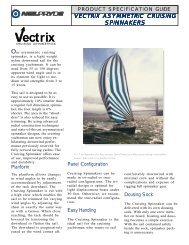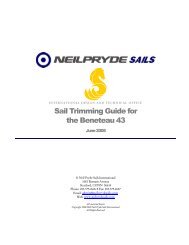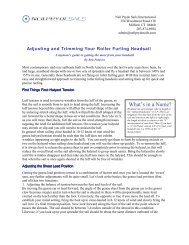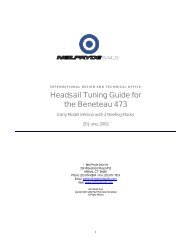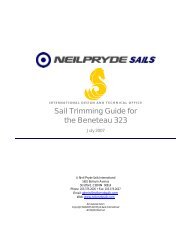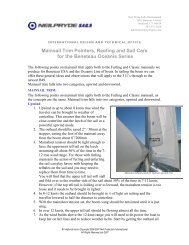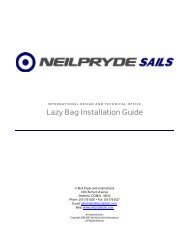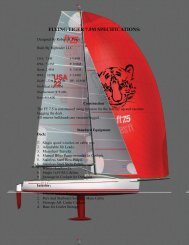Vertically Battened Mainsail Overview & Handling ... - Neil Pryde Sails
Vertically Battened Mainsail Overview & Handling ... - Neil Pryde Sails
Vertically Battened Mainsail Overview & Handling ... - Neil Pryde Sails
Create successful ePaper yourself
Turn your PDF publications into a flip-book with our unique Google optimized e-Paper software.
<strong>Neil</strong> <strong>Pryde</strong> <strong>Sails</strong> International<br />
1681 Barnum Avenue<br />
Stratford, CT 06614<br />
203-375-2626<br />
admin@neilprydesails.com<br />
INTERNATIONAL DESIGN AND TECHNICAL OFFICE<br />
<strong>Vertically</strong> <strong>Battened</strong> <strong>Mainsail</strong> <strong>Overview</strong> &<br />
<strong>Handling</strong> / Trim Guide for the Oceanis Series<br />
<strong>Overview</strong>:<br />
The <strong>Neil</strong> <strong>Pryde</strong> <strong>Sails</strong> PBF or Power Batten Furling mainsail adds a more ‘classic’ look to the visual aesthetics<br />
of the mainsail while improving the aerodynamic efficiency and increasing the area of the mainsail. In<br />
working directly with US Spars and Beneteau in developing this vertically battened furling mainsail our<br />
goals were to provide improved performance without the loss of handling ease which makes in-mast furling<br />
systems so popular.<br />
Details:<br />
In-mast furling mains are generally about 18-20% smaller than the classic mainsails and the PBF<br />
mainsails gain back 50% of this lost area. The performance gains due to increased area are<br />
obvious, but the boat will also gain an improvement in upwind performance due to the<br />
increased leech area, which makes dramatic improvements to the foil efficiency. The result is<br />
better airflow and increased pointing ability over the conventional furling mainsail. These<br />
sails are designed fairly flat to ensure ease of mechanical furling and with a specific amount<br />
of clew “rise” also to help facilitate smooth furling. Each mainsail is equipped with 4<br />
vertical battens that are inserted with an internal Velcro tensioning system. In addition an<br />
external U.V. clew cover to protect the exposed sail surface from sunlight when furled is<br />
standard.<br />
All PBF mainsails are equipped with a safety clew ring to be used in the unlikely<br />
chance of clew block failure. Patch styles include reefing ‘buffer’ patches at head and<br />
tack that help to disperse sail loads when reefed and our new ‘spider’ clew patch that<br />
significantly lightens the corner reinforcement while improving the stability of the clew<br />
area.<br />
The 423 PBF <strong>Mainsail</strong>
<strong>Neil</strong> <strong>Pryde</strong> <strong>Sails</strong> International<br />
1681 Barnum Avenue<br />
Stratford, CT 06614<br />
203-375-2626<br />
admin@neilprydesails.com<br />
Sail <strong>Handling</strong>:<br />
1. The boom vang (kicker) should be off completely and the mainsheet eased before furling or<br />
unfurling the mainsail<br />
2. The mainsail should always be furled with the boat head-to-wind or slightly from port. This is true<br />
for furling and unfurling the mainsail.<br />
3. Furling or unfurling the sail with the wind on the starboard quarter will increase the friction of the<br />
sail on the mast, causing unnecessary wear.<br />
4. Always take additional care when furling or unfurling at the bottom most batten, as the furled sail<br />
diameter is at its largest point and the internal friction is greatest at this point.<br />
Reefing:<br />
Reefing the mainsail, headsail or both in combination allows the skipper to keep the trim of the boat in a<br />
more upright mode. This is a safer, more comfortable and faster way to sail in strong breezes. In addition,<br />
reefing the sails importantly affects the balance of the boat and can increase or decrease the amount of<br />
weather helm that develops at the wheel. The timing and sequence of reefing is up to the skipper of the boat<br />
to consider and will vary from skipper to skipper, as some conditions or preference in how the boat is sailed<br />
in reefing conditions are variable. With this in mind, the following points are general observations.<br />
1. The ‘balance’ of helm is regulated through mast rake, fore and aft. This will be preset during the<br />
initial commissioning.<br />
a. More mast rake aft will move the sailplan center of effort aft, in effect putting more loads on<br />
the sails aft of the keel. This will then in turn ‘pivot’ the boat around the keel, bringing the<br />
bow into the wind.<br />
b. Mast rake forward and the opposite is true, the balance moves forward and the boat will gain<br />
neutral or lee helm.<br />
2. Weather helm is desirable in all sailing yachts. It keeps the bow into the wind while sailing upwind<br />
and improves your VMG to weather.<br />
a. In 10 to 12 knots of wind with the sails fully deployed we expect to have the helm just<br />
slightly above neutral or with a small amount of helm. This means in releasing the wheel, the<br />
boat will (depending on wind, sea conditions and boat trim) slowly come into the wind.<br />
3. As you reef the sails, you are also going to affect the balance or center of effort on the sailplan.<br />
a. Reefing the genoa will reduce the area of this sail and in turn moves the center of effort aft,<br />
increasing helm.<br />
b. Reefing the mainsail first, will move the center of effort forward and decrease the weather<br />
helm.<br />
With these points in mind, we generally recommend that both the mainsail and genoa be reefed in tandem at<br />
the first shortening of sail. This will ensure a balanced helm as the breeze initially builds. Though you may<br />
be somewhat underpowered initially, as sailors we find it safer to assume the wind will continue to build and<br />
it is always more prudent to reef earlier than later. Should the wind decrease, increasing the sail area is easily<br />
accomplished by deploying the genoa so it can be full sized again.<br />
Assuming the breeze continues to build into the twenties, it is important to have a sense of how much
<strong>Neil</strong> <strong>Pryde</strong> <strong>Sails</strong> International<br />
1681 Barnum Avenue<br />
Stratford, CT 06614<br />
203-375-2626<br />
admin@neilprydesails.com<br />
weather helm you have. If you find yourself fighting to keep the bow down (the boat continually wanting to<br />
come up hard into the wind) then you need to reduce the mainsail area by furling the mainsail into the mast.<br />
This will establish the balance back to the helm and also decrease the total net area, making the boat more<br />
upright and comfortable. Note the following:<br />
1. Furling mainsails offer the user infinite reefing positions as compared to fixed reefing points found<br />
on traditional mainsails. The only exception to this is that when reefed the sail should<br />
not be reefed with a batten partially in or out of the mast. Reefing points should<br />
be on either side of a batten for best results.<br />
2. Typically reefing the mainsail so that the uppermost batten is just behind the<br />
mast will reduce the area of the mainsail by 30-35%, reefing to the second<br />
highest batten will reduce the area by 65-75%. (this compares to 25 and 45% on<br />
the Classic mainsails)<br />
3. Given this reduction, we recommend a starting place for the first reef to be<br />
about three quarters of the way to the uppermost batten and the second reef half<br />
way between the uppermost and second batten. These of course will be<br />
variable as outlined in the paragraphs above.<br />
Upwind Trim:<br />
1. We have found that upwind in up to about 8-knots true wind the traveler on the<br />
mainsail can be brought to weather of centerline. This ensures that the boom will be<br />
centerline at the aft end.<br />
2. Mainsheet tension should be tight enough to have the uppermost tell tail on the<br />
leech streaming aft about 50% of the time in this 7-12 true wind range. You will<br />
find that the upper tell tail will stall and fold over to the weather side of the sail<br />
about 50% of the time. If it is folding over to leeward, the mainsheet<br />
tension is too loose.<br />
3. With the mainsheet tension set, the boom vang should be snug at this<br />
point.<br />
4. In over 12 knots, the upper tell tail should be flowing almost all the<br />
time.<br />
5. As the wind builds above the 12-knot range you will need to depower<br />
the boat to keep her on her lines and to reduce weather helm. Let<br />
the traveler down in 3" increments until the boat balances. If the<br />
action of lowering the traveler to balance the helm causes the<br />
mainsail to backwind, this means it is time to furl the mainsail.<br />
Downwind:<br />
1. The vang set as above will get you pretty close to the right trim.<br />
2. As soon as you crack off bit, even as little as 3 0 , ease the traveler down in 3" increments until the boat<br />
balances and drives well.<br />
PG-38 Safety Ring
<strong>Neil</strong> <strong>Pryde</strong> <strong>Sails</strong> International<br />
1681 Barnum Avenue<br />
Stratford, CT 06614<br />
203-375-2626<br />
admin@neilprydesails.com<br />
3. 6 0 and deeper, the traveler will be all the way out and you will start to ease the mainsheet. The leech<br />
should be set correctly, assuming the vang was tightened as above and all your tell tails flowing aft. With a<br />
battened mainsail (Classic), you normally keep the top batten parallel to the boom…and you do this with the<br />
boom vang. Obviously, with vertical battens there you will need to eyeball it. If the top batten is falling off to<br />
leeward you need to tighten the vang to bring it back in line with the boom.<br />
4. With the leech trimmed this way, both tell tails should fly aft 95% of the time.<br />
All material herein<br />
Copyright 2007-2008 <strong>Neil</strong> <strong>Pryde</strong> <strong>Sails</strong> International<br />
All Rights Reserved



